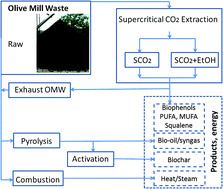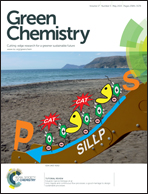An integrated biorefinery concept for olive mill waste management: supercritical CO2 extraction and energy recovery†
Abstract
Commercial production of olive oil generates four times the amount of waste as it does oil, along with a number of environmental issues. We propose an integrated biorefinery concept for the management of pomace, i.e. solid Olive Mill Waste (OMW), that utilizes supercritical carbon dioxide (SCO2), coupled with a polar co-solvent (Ethanol), for extracting value-added polyphenols and mono/poly-unsaturated fatty acids (MUFA/PUFA), followed by thermochemical (oxidation or pyrolysis) recovery of energy, biofuels and materials. The SCO2 + EtOH extraction recovered 77.6 g of freeze-dried extract per kg of raw OMW, with relatively high concentrations in polyphenols (10.9 g kg−1 of which 60.1% of di-hydroxytyrosol), PUFA (20 g kg−1), MUFA (601 g kg−1) and other valuable compounds, such as squalene (10 g kg−1). All these substances are of extreme interest in pharmaceutical and nutraceutical market, for their antioxidant, anti-cancer, functional, anti-bacterial and nutritional properties. The SCO2 + EtOH flux acted as physical/chemical carrier for over 85% of humidity, leaving the exhaust OMW almost dry, with evident advantages for downstream. Using nonisothermal thermogravimetric analysis, the apparent activation energies required to pyrolyze OMW to produce fuel and biochar ranged from 20 to 140 kJ mol−1 depending on heating ramp rate and temperature regime. BET analysis of unactivated biochars show increased (+25%) mesopore surface areas after SCO2 extractions (up to 500 m2 g−1). A more in-depth view on the proposed biorefinery is needed, to consider the overall energy balance, as well as possible market values of the obtained extract, and evaluate the real feasibility of the proposed concept.


 Please wait while we load your content...
Please wait while we load your content...